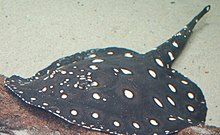Xingu River ray
| Xingu River ray | |
|---|---|

| |

| |
| Scientific classification | |
| Domain: | Eukaryota |
| Kingdom: | Animalia |
| Phylum: | Chordata |
| Class: | Chondrichthyes |
| Subclass: | Elasmobranchii |
| Superorder: | Batoidea |
| Order: | Myliobatiformes |
| Family: | Potamotrygonidae |
| Genus: | Potamotrygon |
| Species: | P. leopoldi
|
| Binomial name | |
| Potamotrygon leopoldi | |
The Xingu River ray, white-blotched river stingray, or polka-dot stingray (Potamotrygon leopoldi) is a species of freshwater fish in the family Potamotrygonidae. It is endemic to the Xingu River basin in Brazil and as such prefers clear waters with rocky bottoms.[1] It is sometimes kept in aquaria, like its more common relative the Motoro.[1]
Etymology
The fish is named in honor of
Description
Potamotrygon leopoldi reaches up to 40 cm (16 in) in disc width,
The Xingu river ray is a venomous stingray that contains venom localized at its dentine spine in its tail.[9] While the ray's venom composition does not change with maturation, the venom toxicity decreases as rays get older.[9] On the other hand, rays' jaw shape, stiffness, and mineralization are strengthened with age, which allows mature rays the ability to consume hard-shelled invertebrates.[10] These changes in traits with maturation reflect the different pressures rays experience in terms of functions such as feeding and avoiding predation during different maturity stages.[9]
References
- ^ doi:10.2305/IUCN.UK.2022-2.RLTS.T39403A2923696.en. Retrieved 9 December 2022.)
{{cite journal}}: CS1 maint: multiple names: authors list (link - ^ "Appendices | CITES". cites.org. Retrieved 2022-01-14.
- ^ Christopher Scharpf & Kenneth J. Lazara (22 September 2018). "Order MYLIOBATIFORMES (Stingrays)". The ETYFish Project Fish Name Etymology Database. Christopher Scharpf and Kenneth J. Lazara. Retrieved 11 November 2021.
- ^ Froese, Rainer; Pauly, Daniel (eds.) (2017). "Potamotrygon leopoldi" in FishBase. February 2017 version.
- ^ Fishing World-records: Potamotrygon leopoldi. Retrieved 22 February 2017.
- ^ "Polka-dot stingray, Potamotrygon leopoldi". Animals. Dallas World Aquarium. Retrieved 25 January 2016.
- ^ PMID 27701358.
- ^ Ministry of the Environment, pp. 1–33
- ^ PMID 25449099.
- S2CID 96436321.
 Media related to Potamotrygon leopoldi at Wikimedia Commons
Media related to Potamotrygon leopoldi at Wikimedia Commons

